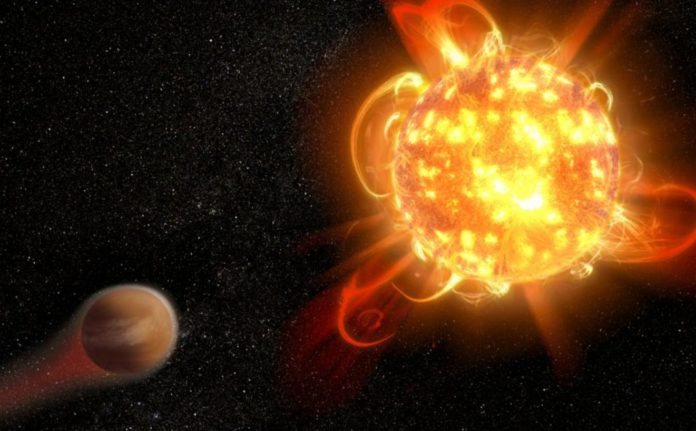The team observed 10 times bigger and most powerful coronal mass ejection ever recorded from a sun-like star
If a coronal mass ejection strikes Earth directly, it could fry satellites in space and knockdown power grids that serve entire cities.
Astronomers who were watching a stellar system a few hundred light-years away from Earth have seen very unusual fireworks show for the first time. A star, called EK Draconis, emitted a huge burst of energy and charged particles that was much more powerful than anything scientists have ever seen in our own solar system.
The paper delves into a stellar event known as a “coronal mass ejection,” sometimes known as a solar storm. Notsu stated that the sun produces these kinds of eruptions on a regular basis; they are made up of clouds of incredibly hot particles, or plasma, that may travel across space at millions of miles per hour. And they might be bad news: If a coronal mass ejection hits Earth directly, it could fry satellites in space and knockdown power lines that serve entire cities.
“Coronal mass ejections can have a serious impact on Earth and human society,” says astrophysicist Yuta Notsu.
The latest study, lead by Kosuke Namekata of Japan’s National Astronomical Observatory and formerly a visiting scholar at CU Boulder, also warns that things could grow much worse.
Namekata, Nostu, and their colleagues utilized telescopes on the ground and in orbit to examine EK Draconis, which resembles a baby sun. The researchers saw EK Draconis expelling a cloud of scorching-hot plasma with a mass in the quadrillions of kilograms in April 2020, which was more than ten times larger than the most violent coronal mass ejection ever recorded from a sun-like star.
The event could serve as a warning about how dangerous the weather in space can be.
“This kind of big mass ejection could, theoretically, also occur on our sun,” said Notsu.
“This observation may help us to better understand how similar events may have affected Earth and even Mars over billions of years.”
Notsu noted that coronal mass ejections frequently occur immediately after a star emits a flare, which is a quick and bright burst of radiation that can spread far into space.
Recent research, however, suggests that this series of events on the sun may be relatively calm, at least as far as scientists can tell. Notsu and his colleagues, for example, published a study in 2019 demonstrating that young sun-like stars throughout the galaxy appear to be subjected to periodic superflares, which are similar to our own solar flares but tens or even hundreds of times more violent.
Such a superflare may conceivably occur on Earth’s sun, but only on an extremely rare basis, perhaps once per several thousand years. Still, it piqued Notsu’s team’s interest: Could a superflare also result in a super coronal mass ejection?
“Superflares are much bigger than the flares that we see from the sun,” added Notsu.
“So we suspect that they would also produce much bigger mass ejections. But until recently, that was just conjecture.”
To find out, the researchers focused on EK Draconis. Notsu noted that the strange star is around the same size as our sun, but at only 100 million years old, it’s a relative newcomer in cosmic terms.
“It’s what our sun looked like 4.5 billion years ago,” Notsu added.
The researchers used NASA’s Transiting Exoplanet Survey Satellite (TESS) and Kyoto University’s SEIMEI Telescope to monitor the star for 32 nights in winter and spring 2020. On April 5, Notsu and his colleagues struck gold: they witnessed EK Draconis erupt into a massive superflare. After around 30 minutes, the researchers noticed what seemed to be a coronal mass ejection shooting away from the star’s surface. The researchers only caught the first stage of the ejection’s life, known as the “filament eruption” phase. Even so, it was a monster, with a top speed of about 1 million miles per hour.
It may also not bode well for life on Earth, as the team’s findings suggest that the sun is capable of such severe extremes as well. But don’t hold your breath—super coronal mass ejections, like superflares, are likely to be rare around our getting-on-in-years sun.
Nonetheless, Notsu speculated that massive mass ejections may have been significantly more common in the solar system’s early years. Gigantic coronal mass ejections, in other words, could have aided in the formation of planets like Earth and Mars into what they are today.
“The atmosphere of present-day Mars is very thin compared to Earth’s,” Notsu said.
“In the past, we think that Mars had a much thicker atmosphere. Coronal mass ejections may help us to understand what happened to the planet over billions of years.”
Source: 10.1038/s41550-021-01532-8
You were reading: A sun-like baby star could one day threaten Earth, scientists warn
